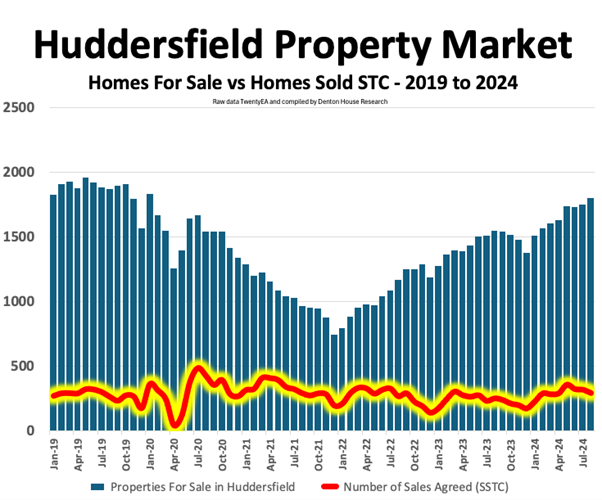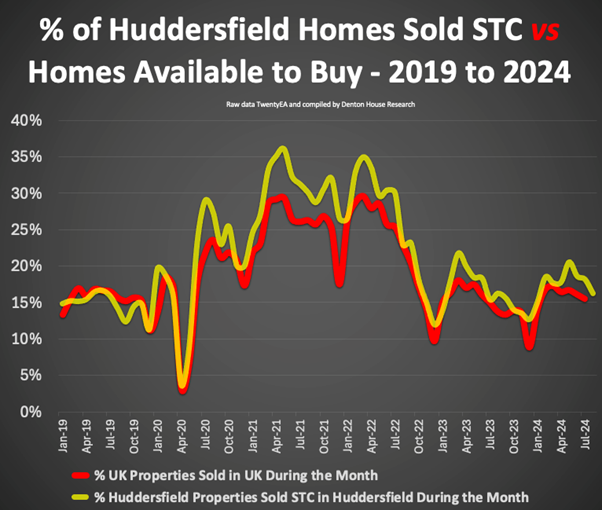|
It’s
no secret that the younger generation in Huddersfield is finding it tough
to get onto the property ladder. With the rising cost of living,
stagnating wages, and stricter mortgage criteria, it's no surprise that
fewer under-34s are becoming homeowners.
But
just how grim is the picture? And is there hope on the horizon for those
struggling to find a place they can truly call home?
Huddersfield's
Housing Crisis: The Struggles of the Under-34s
According
to statistics for the Kirklees Council area, there are 177,988 households
in total.
Of
these, 2.7%
are headed by individuals aged between 16 and 24, while 13.3% are headed
by individuals aged between 25
and 34.
Compared
with 2.6% of all UK households that are made up of people aged
between 16 and 24 and 13.5% of all UK households made up of people
aged between 25 and 34.
Looking
specifically at the 16 to 24-year-old households in Kirklees, they can be
broken down as follows…
- Owned Outright – 3.9%
- Owned with a Mortgage – 13.5%
- Social Housing – 22.1%
- Private Rented – 60.5%
Nationally,
this compares owned outright 3.6%, owned with a mortgage 10.2%, social
housing 22.8% and private renting 63.5%.
Next,
the 25 to 34-year-old households in Kirklees breakdown…
- Owned Outright – 5.5%
- Owned with a Mortgage – 39.4%
- Social Housing – 16.1%
- Private Rented – 38.9%
Nationally,
this compares owned outright 4.1%, owned with a mortgage 35.5%, social
housing 17.7% and private renting 42.7%.
For
a town like Huddersfield and local authority area, these numbers paint a
rather bleak picture of property ownership among the younger generation.
But
why is this happening? The answer is multifaceted. It’s not just about
rising house prices (although they certainly play a role). Wages in
Huddersfield have not kept pace with inflation, and with lenders becoming
more conservative, the amount of deposit required to secure a mortgage is
higher than ever before (not because the % of deposit is higher, just the
sheer pound note amount).
For
young people who are already grappling with student debt and rising
rental costs, saving for a deposit can seem like an insurmountable task.
The
Shifting Sands of Homeownership
Yet,
while it might feel like homeownership for the under-34s in Huddersfield
is slipping further out of reach, it’s worth putting these figures into
context. Homeownership isn’t something that young people have ever done en masse, at least
not in the recent decades of the 2000s and 2010s.
While
the baby boomer generation often bought homes in their early to mid-20s
(in the 1970s and 1980s), the dynamics of homeownership have changed
dramatically since then.
The
average age of first times buyers in the 1980s was 26, now the average
age is 31 years (34 in London).
In
the 1980s, when the housing market was more accessible, people were more
likely to buy a home at a younger age. However, times have changed, and
today's generation is navigating a very different set of economic and
social circumstances. The cost of housing has skyrocketed, while wages
have not kept pace. Furthermore, younger people today are often burdened
with additional expenses that weren’t as prevalent a few decades ago,
such as student loans and rising living costs. This combination makes it
much harder to save for a deposit and secure a mortgage.
But
while the statistics may seem gloomy, there’s a silver lining if we look
beyond the current market and consider the long term. In countries like
Germany, homeownership doesn’t typically happen until later in life.
Germans tend to rent for longer, often well into their 30s and 40s,
before purchasing a home. Yet, when they do finally buy, they have more
financial stability, higher incomes, and can often make larger down
payments. The result? Less debt and more security in the long run.
This
delayed homeownership is becoming more common in the UK, and Huddersfield
is no exception. What we may be seeing is not a permanent decline in
young homeowners but a shift in the timing of when people buy. Instead of
purchasing homes in their 20s, more people are waiting until their mid
30s or even 40s, when they have a bit more financial stability.
The
Hidden £18,311,148,466 Kirklees Equity
One
key factor that we cannot ignore is the £18.3bn of equity tied up in the
homes of the 50 year plus older generation in Kirklees.
Many
of our older residents, who bought homes decades ago when property prices
were more affordable, are now sitting on this substantial equity. As
these homeowners begin to downsize or pass their properties onto their
children, we may see a significant transfer of wealth to the younger
generation. This could provide a lifeline for many would-be homeowners
who are currently priced out of the market.
In
Huddersfield, where family connections are strong, and homeownership is
often passed down through generations, this transfer of wealth is likely
to have a profound impact on the housing market in the coming years. As
baby boomers and older Gen X-ers look to pass on their properties, many
younger people may find themselves with the financial means to finally
purchase a home.
What
Does This Mean for the Future of Huddersfield Homeownership?
The
future of homeownership in Huddersfield isn’t all doom and gloom. Yes,
the statistics show that fewer young people are owning homes, but this
isn’t a permanent trend. The numbers may be low now, but there are
several reasons to be optimistic about the future.
Firstly,
as more young people start to prioritise saving and look for ways to get
onto the property ladder, we could see an increase in homeownership rates
among the under-34s. Previous schemes, such as Help to Buy and shared
ownership can also provide much-needed assistance for first-time buyers
in Huddersfield.
Secondly,
as the older generation begins to pass on their wealth and property,
younger people will likely have more opportunities to purchase homes,
either through inheritance or through financial gifts. This generational
shift will undoubtedly play a significant role in the future of
Huddersfield’s property market.
While
homeownership might not be happening as early as it did in previous
decades, it is still very much attainable for those who are willing to
plan and save strategically.
There’s
no denying that the market is tough, but with the right guidance and
support, many young people in Huddersfield will find that they can, in
fact, become homeowners.
The
key is to be patient, stay informed, and seek out opportunities as they
arise.
As
we look towards the future, it’s clear that the property market in
Huddersfield is changing. Young people may not be buying homes as early
as they did in the past, but that doesn’t mean they never will.
In
fact, the next few decades could see a rise in homeownership as wealth
transfers down through generations and more young people become
financially stable.
In
conclusion, the Huddersfield property market may be challenging for those
under 34, but it is far from hopeless. The combination of shifting
generational wealth and changing attitudes towards homeownership means
that while young people may be delayed in buying homes, they aren’t being
locked out of the market entirely.
Huddersfield’s
future homeowners are out there – they’re just waiting a little longer to
step onto the ladder. Share your thoughts with a comment.
|

